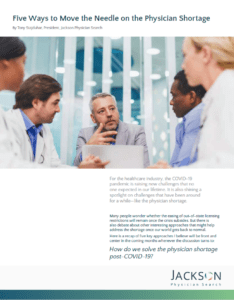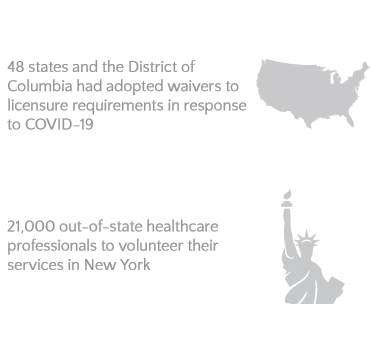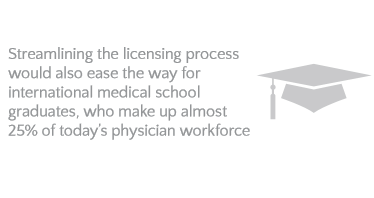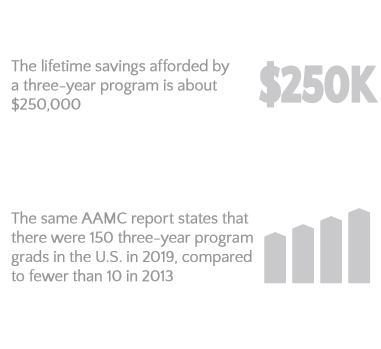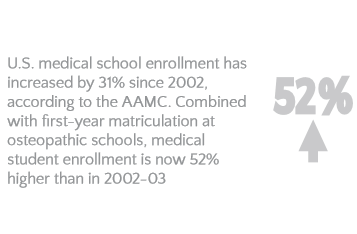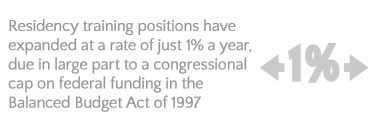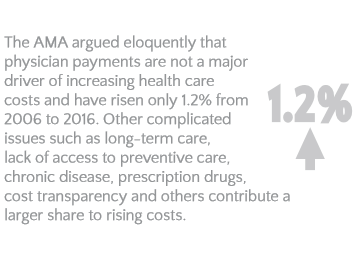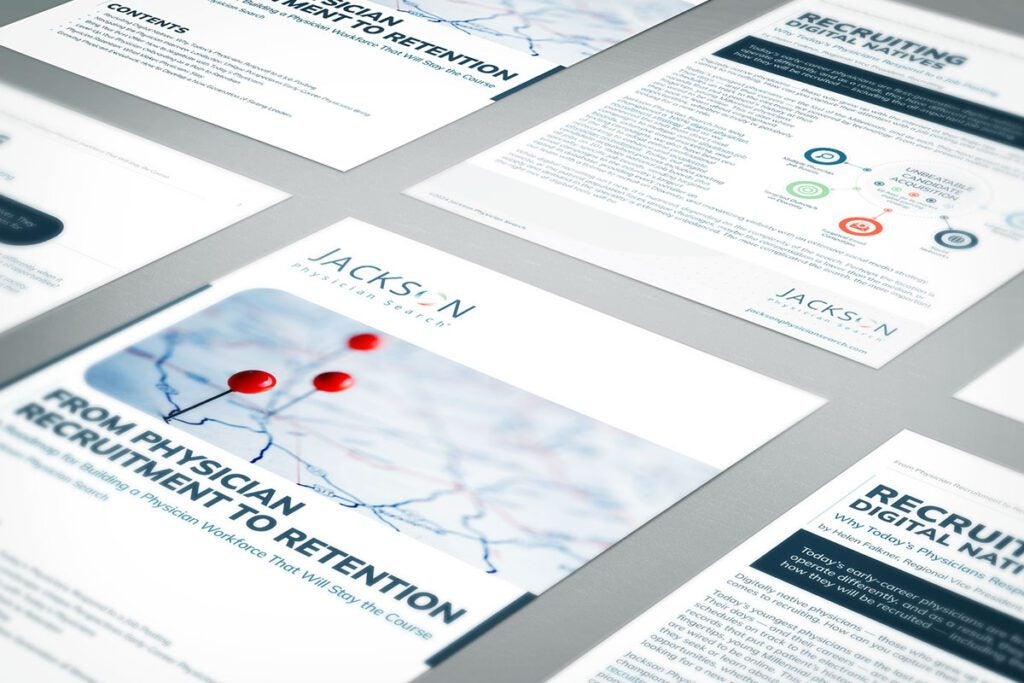Download 5 Ways to Move the Needle on the Physician Shortage
For the healthcare industry, the COVID-19 pandemic is raising new challenges that no one expected in our lifetime. It is also shining a spotlight on challenges that have been around for a while—like the physician shortage.
Many people wonder whether the easing of out-of-state licensing restrictions will remain once the crisis subsides. But there is also debate about other interesting approaches that might help address the shortage once our world gets back to normal. Here is a recap of five key approaches I believe will be front and center in the coming months whenever the discussion turns to: How do we solve the physician shortage post-COVID-19?
1. Make Licensing Waivers Permanent
If anything good can be said about the coronavirus, it’s that it is providing a beta test for doctors licensed in one state to practice just about anywhere. The Federation of State Medical Boards reported April 23, 2020 that 48 states and the District of Columbia had adopted waivers to licensure requirements in response to COVID-19.
That helped make possible, for example, the more than 21,000 out-of-state healthcare professionals to volunteer their services in New York, the state with the most U.S. coronavirus cases at the time of this writing.
Will the waivers continue once the pandemic is over? I know there is much debate over the possible move to a single national standard for physician licensing. But who can argue with slashing red tape to make it easier to provide care to those who need it?
As the author of a recent Forbes magazine article puts it: “Why should a doctor who’s good enough to practice in California be unable to do so in New York?”
Why should a doctor who’s good enough to practice in California be unable to do so in New York?
If one does view the waivers as the de facto adoption of a national standard, it will certainly be of interest to see the data on how it impacted the practice of medicine during the pandemic.
The rise of telemedicine, especially its value during the pandemic, will no doubt fuel the argument that we should continue to make it easier for physicians to care for patients in other states. At the very least, some sort of lasting mutual recognition agreement, in which states honor each other’s physician licenses, might be in order.
Streamlining the licensing process would also ease the way for international medical school graduates, who make up almost 25% of today’s physician workforce.
2. Do Something About Physician Student Debt
Physicians have shown their heroic stripes during the pandemic, especially Millennial physicians who volunteered to work in high-impact areas because of their reduced risk of catching the virus. Federal government hazard pay such as New York Governor Andrew Cuomo’s proposal for front-line workers is one way to recognize their effort, but young doctors point out that the few extra thousand dollars is pocket change compared with the hundreds of thousands of dollars of student loan debt they owe.
We endorse the American Medical Association’s April 7 request to Congress extending federal student loan forgiveness for doctors caring for patients on the frontlines of the COVID-19 epidemic, but it doesn’t address what happens once the epidemic is over.
According to the Association of American Medical Colleges (AAMC), median medical school debt was $200,000 in 2018. That debt pressure can steer new doctors away from research, community-based work and general practice, which may not be as highly paid as medical specialties
Not every school can do what the NYU School of Medicine did to be the first private U.S. medical school—and the only one ranked in the top 10—to offer free tuition to all its students. The yearly tuition costs covered by the scholarship are $55,018. While few institutions have the endowment for this kind of undertaking, it raises an opportunity for others to explore. The free-tuition initiative began more than a decade ago, when NYU created the endowment and began raising the roughly $600 million it estimates will be needed to keep the program ongoing.
What about public medical schools? The student debt burden isn’t as high as private medical schools, but still substantial. The average four-year cost for public school students is $243,902, according to the AAMC, compared with $322,767 for private school students. Still, paying off loans for those four years is a big burden to carry.
The average four-year cost for public school students is $243,902, according to the AAMC, compared with $322,767 for private school students
Sure, there are tools like the federal government’s income-driven repayment program where monthly payments are a percentage of discretionary income, rather than traditional repayment plans where students make payments based on the amount of money they owe. By working for nonprofit facilities or the government, working in medically underserved areas, or joining the military, students can reduce medical school debt, as well.
While such programs offer some relief, they don’t get to the heart of the problem that medical school costs are simply out of reach for many qualified students. Shortening the path to becoming a doctor is one approach to bringing costs down.
3. Make Becoming a Doctor More Affordable
In the 1970s, rising gas prices were one of the factors that led the auto industry to redesign American cars to be smaller and more efficient. That same kind of evolution is brewing among some medical schools today.
The Forbes article mentioned earlier points to the lengthy path in the U.S. for a student to become a physician. While in the U.S., the typical doctor spends four years in college, four years in med school and anywhere from three to seven years in post-graduate residency and fellowship, students in almost every other developed country can earn a medical degree in six years or less—and then begin residency.
While in the U.S., the typical doctor spends four years in college, four years in med school and anywhere from three to seven years in post-graduate residency and fellowship, students in almost every other developed country can earn a medical degree in six years or less—and then begin residency
As the article points out, some U.S. medical schools have responded to the pandemic by graduating students ahead of time to help fight COVID-19. Measures like these don’t have to temporary, writes the author of the article.
Three-year M.D. programs that started before the pandemic—like those at Texas Tech, NYU and Duke—have shown strong signs of success, helping cut student debt and produce grads faster.
The savings are significant. An AAMC report quotes research showing that, with tuition cuts and an extra year of salary, the lifetime savings afforded by a three-year program is about $250,000.
Skeptics argue that the shorter cycle robs young doctors of valuable experience before they begin practice, adds to stress that can lead to early burnout, and limits the time students need to explore all the specialty options available. Proponents of the shorter programs cite research showing that three-year grads perform on par with traditional four-year grads.
We feel certain the debate will continue, but momentum is growing for a wider range of three-year programs for young hopefuls to choose from.
The same AAMC report states that there were 150 three-year program grads in the U.S. in 2019, compared to fewer than 10 in 2013. And the Consortium of Accelerated Medical Pathway Programs, launched in 2015 by eight schools in the U.S. and Canada with funding from the Josiah Macy Jr. Foundation, grew to 16 last year.
4. Increase Residency Slots
One bright piece of news in the stories about the physician shortage is that U.S. medical school enrollment has increased by 31% since 2002, according to the AAMC. Combined with first-year matriculation at osteopathic schools, medical student enrollment is now 52% higher than in 2002-03.
It’s the result of an AAMC initiative begun in 2006 that called on medical schools to increase first-year enrollment by 30%. That target was reached in 2018-19, when first-year matriculation reached 21,622 students. Osteopathic schools increased their enrollment by 164% during this same time period, with 8,124 first-year students enrolled.
The next step is to increase the number of residency slots
The next step is to increase the number of residency slots. “From a supply side perspective, what we really need to focus on now is the residency slots,” says Atul Grover, MD, PhD, executive vice president of the AAMC. “We’ve done everything we can on the medical school front to reduce the physician shortage, and I think the numbers bear that out. The federal government needs to resume covering its fair share of the costs. That starts by lifting the caps.”
Residency training positions have expanded at a rate of just 1% a year, due in large part to a congressional cap on federal funding in the Balanced Budget Act of 1997. Most of the costs of residency training — about $171,855 per year, per resident on average, according to AAMC data — are supported by teaching hospitals and their faculty. Medicare (U.S. Department of Health and Human Services) has historically paid for 21% of the training.
However, that support has been largely frozen since 1997 with the unfortunate state of gridlock in Washington, D.C. A house bill introduced last year – the Resident Physician Shortage Reduction Act of 2019 (H.R. 1763) – would add up to 15,000 Medicare-funded residency positions over five years as a means to increase the number of practicing physicians, and is similar to an AHA-supported bill introduced in April in the Senate. The Senate bill has been referred to the Senate Finance Committee and the House bill to the Subcommittee on Health.
It’s shameful that an adequate number of residency slots for a nation struggling with a physician shortage has become a political issue, but that’s the way of our world today.
Some teaching hospitals are supporting residency positions over their caps without any federal support. They are also working with hospitals that have never been teaching hospitals to establish new residency training programs.
5. Change Payment Mechanisms
Public opinion is a fickle thing, but I think the COVID-19 crisis, and the heroic role physicians have played in it, might very well sway public opinion regarding how doctors get paid in the future. I also think it might very well embolden doctors—and rightly so—to demand better payment for their services—or at least demand a greater choice of payment options for their services.
The days of COVID-19 are rough for physicians. With elective surgeries put on hold across the country as hospitals grapple with the influx of patients infected by the coronavirus, group practices are struggling. Physicians are temporarily shutting their doors
Let’s face it. The days of COVID-19 are rough for physicians. With elective surgeries put on hold across the country as hospitals grapple with the influx of patients infected by the coronavirus, group practices are struggling. Physicians are temporarily shutting their doors or—those who can afford it—retiring in response to the pandemic. This will in turn pose a challenge to hospitals already grappling with staffing gaps and attempts to return to normal once the crisis subsides.
The American Medical Association opposed a California price-fixing bill that would have set rates for all health services covered by commercial health insurance plans using Medicare rates as a benchmark, and the bill eventually failed. But that doesn’t mean other states might not consider similar measures in an attempt to lower healthcare costs after the height of the COVID-19 crisis. Our doctors deserve better.
The AMA argued eloquently that physician payments are not a major driver of increasing health care costs and have risen only 1.2% from 2006 to 2016. Other complicated issues such as long-term care, lack of access to preventive care, chronic disease, prescription drugs, cost transparency and others contribute a larger share to rising costs. Maybe the COVID-19 crisis will help the public—and its lawmakers—understand those issues better—and pay physicians what they are worth.
It has been encouraging in recent years to see hospital payment models shift from being based not only on productivity goals but also to reflect the physician’s contribution to quality improvement as the value of care is measured. And hospital administrators are becoming creative by including flexible scheduling, reduced or no call hours, signing bonuses and student loan forgiveness to attract candidates to ongoing vacancies.
Build a better house
I heard a great analogy the other day that went something like: If your house burns down, are you going to rebuild it exactly the way it was, or are you going to build your dream house? It’s obvious that old ways need to change if we’re going to seriously tackle the predicted shortage of nearly 122,000 physicians by 2032. The ideas presented here are a starting point, at least, for building a house that everyone in the healthcare industry can be proud of.
Download 5 Ways to Move the Needle on the Physician Shortage
Need Help Recruiting Physicians?
Click the Get Started button if you’re ready to speak with one of our physician recruitment experts.
